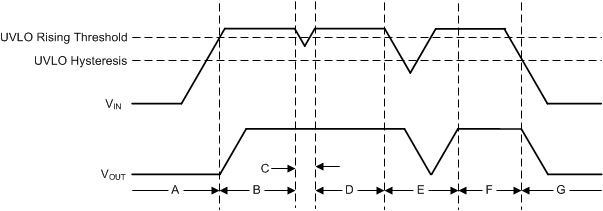ZHCSQC5D December 2022 – June 2025 TPS7A21-Q1
PRODUCTION DATA
封装选项
机械数据 (封装 | 引脚)
散热焊盘机械数据 (封装 | 引脚)
订购信息
7.1.4 欠压锁定 (UVLO) 操作
UVLO 电路可确保在输入电源达到最小工作电压范围之前器件保持禁用状态,并确保在输入电源崩溃时器件关断。图 7-2 展示了 UVLO 电路对各种输入电压事件的响应。该图分为以下几个部分:
- 区域 A:在输入达到 UVLO 上升阈值之前,器件不会启动。
- 区域 B:正常运行,调节器件。
- 区域 C:高于 UVLO 下降阈值(UVLO 上升阈值 – UVLO 迟滞)的欠压事件。输出会超出稳压范围,但器件保持启用状态。
- 区域 D:正常运行,调节器件。
- 区域 E:低于 UVLO 下降阈值的欠压事件。由于存在负载和有源放电电路,该器件在大多数情况下会被禁用,并且输出会下降。当输入电压达到 UVLO 上升阈值时,器件将重新启用,随后会正常启动。
- 区域 F:正常运行,然后输入下降至 UVLO 下降阈值。
- 区域 G:当输入电压降至 UVLO 下降阈值以下达到 0V 时,该器件被禁用。输出会因为负载和有源放电电路而下降。
 图 7-2 典型 UVLO 运行
图 7-2 典型 UVLO 运行